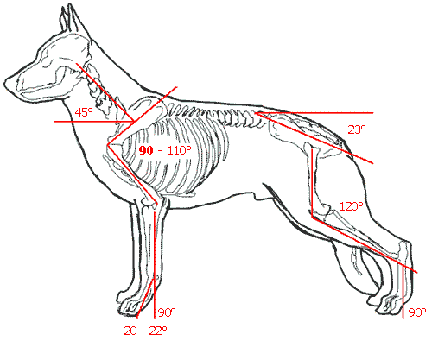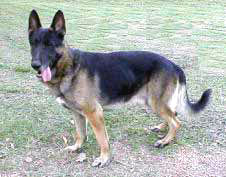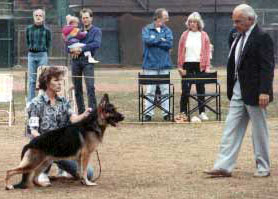Complete GSD Standard
for the German Shepherd Dog
The GSD Standard's main purpose is to inform breeders and all other interested parties about the breed qualities that compose the perfect German Shepherd dog. Basically, this is a "picture" in text only of what the "ideal" German Shepherd Dog should be.
In the United States, the German Shepherd Dog Club of America developed their own GSD Standard, while in Europe, the Fédération Cynologique Internationale (FCI) uses the one written and used in Germany.
The German/FCI version is a very "by the numbers" account compared to the more interpretative values in the AKC GSD Standard version.
Please be advised that the German Shepherd Dog matures very slowly - GSD's are not usually not completely matured until they are 2 1/2 to 3 years old. Keep this in mind when observing your German Shepherd puppy and comparing it to the GSD Breed Standard - younger dogs obviously will not show the same level of maturity and perfection as their older, mature dog counterparts.
Even so, keep in mind that the GSD Standard is merely a written guideline. Your German Shepherd Dog may not have the perfect ear set or the perfect gait but if your German Shepherd Dog is your favorite companion, then who is to say anything more. Tail carriage, coat color, ear size and all the other outer qualities have no impact on the German Shepherd Dogs working ability as detailed in the GSD standard.

AKC German Shepherd Dog Breed Standard
German Shepherd General Appearance
According to the GSD Standard the first impression of a good German Shepherd Dog is that of a strong, agile, well muscled animal, alert and full of life. GSD's are well balanced, with harmonious development of the forequarter and hindquarter.
Also, per the GSD Standard, the German Shepherd Dog breed is longer than tall, deep-bodied, and presents an outline of smooth curves rather than angles. The German Shepherd looks substantial and not spindly, giving the impression, both at rest and in motion, of muscular fitness and nimbleness without any look of clumsiness or soft living.
The ideal German Shepherd is stamped with a look of quality and nobility difficult to define, but unmistakable when present. Secondary sex characteristics of the German Shepherd breed are strongly marked, and every animal gives a definite impression of masculinity or femininity, according to its sex as outlined in the GSD Standard.
German Shepherd Size, Proportion, Substance
The desired height for German Shepherd males, in the GSD Standard, at the top of the highest point of the shoulder blade, is 24 to 26 inches; and for German Shepherd bitches, 22 to 24 inches.
The German Shepherd Dog is longer than tall, with the most desirable breed proportion as 10 to 8-1/2. The GSD standard length is measured from the point of the prosternum or breastbone to the rear edge of the pelvis, the ischial tuberosity.
The German Shepherd's desirable long proportion is not derived from a long back, but from overall length with relation to height, which is achieved by length of forequarter and length of withers and hindquarter, viewed from the side.
GSD Head
The GSD head is noble, cleanly chiseled, strong without
coarseness, but above all not fine, and in proportion to the body. The
GSD Standard further states that the head of the GSD male is distinctly
masculine, and that of the German Shepherd bitch distinctly feminine.
The German Shepherd Dog breed expression is keen, intelligent and composed. Eyes of medium size, almond shaped, set a little obliquely and not protruding.
The German Shepherd Dog color is as dark as possible. German Shepherd Dog ears are moderately pointed, in proportion to the skull, open toward the front, and carried erect when at attention, the ideal carriage being one in which the center lines of the ears, viewed from the front, are parallel to each other and perpendicular to the ground.
Any German Shepherd Dog with cropped or hanging ears must be disqualified, per the GSD Standard for the breed.
Seen from the front the German Shepherd forehead is only moderately arched, and the skull slopes into the long, wedge-shaped muzzle without abrupt stop. The German Shepherd muzzle is long and strong, and the GSD topline is parallel to the topline of the skull. Per the standard, the nose must be black.
A German Shepherd Dog with a nose that is not predominantly black must be disqualified. The lips are firmly fitted. German Shepherd's jaws are strongly developed. Teeth -42 in number-20 upper and 22 lower-are strongly developed and meet in a scissors bite in which part of the inner surface of the upper incisors meet and engage part of the outer surface of the lower incisors.
An overshot jaw or a level bite is undesirable. An undershot jaw is a breed disqualifying fault. Complete GSD dentition is to be preferred in the GSD Standard. Any missing teeth other than first premolars is a serious fault.
German Shepherd Neck, Topline, Body
The German Shepherd's neck is strong and muscular, clean-cut and relatively long, proportionate in size to the head and without loose folds of skin. When the German Shepherd is at attention or excited, the dog's head is raised and the neck carried high; otherwise typical carriage of the GSDs head is forward rather than up and but little higher than the top of the shoulders, particularly in motion.
German Shepherd Topline The GSD withers are higher than and sloping into the level back. The back is straight, very strongly developed without sag or roach, and relatively short. The whole structure of the German Shepherd Dog's body gives an impression of depth and solidity without bulkiness. Chest commencing at the prosternum, it is well filled and carried well down between the dog's legs. The GSD standard further states that the chest is deep and capacious, never shallow, with ample room for the dog's lungs and heart, carried well forward, with the prosternum showing ahead of the shoulder in profile. German Shepherd Dog Ribs Well sprung and long, neither barrel-shaped nor too flat, and carried down to a sternum which reaches to the elbows. Correct ribbing allows the dogs elbows to move back freely when the German Shepherd is at a trot. Too round causes interference and throws the elbows out; too flat or short causes pinched elbows. Ribbing is carried well back so that the German Shepherds loin is relatively short. Abdomen-firmly held and not paunchy. The bottom line is only moderately tucked up in the loin. GSD Loin Viewed from the top, broad and strong. Undue length between the last rib and the thigh, when viewed from the side, is undesirable. German Shepherd Croup Per the GSD Standard, the German Shepherd's is long and gradually sloping.
German Shepherd Tail
Bushy, with the last vertebra extended at least to the hock joint. It is set smoothly into the croup and low rather than high. At rest, the German Shepherd's tail hangs in a slight curve like a saber. A slight hook- sometimes carried to one side is faulty only to the extent that it mars general appearance.
When the German Shepherd Dog is excited or in motion, the curve is accentuated and the dogs tail raised, but it should never be curled forward beyond a vertical line. German Shepherd Dog's tails that are too short, or with clumpy ends due to ankylosis, are serious faults. A German Shepherd with a docked tail must be disqualified per the GSD Standard.

German Shepherd Forequarters The German Shepherd's shoulder blades are long and obliquely angled, laid on flat and not placed forward. The upper arm joins the shoulder blade at about a right angle. Both the upper arm and the shoulder blade are well muscled on the German Shepherd.
The dog's forelegs, viewed from all sides, are straight and the bone oval rather than round. The German Shepherd's pasterns are strong and springy and angulated at approximately a 25-degree angle from the vertical. Dewclaws on the forelegs may be removed, but are normally left on. The GSD's feet are short, compact with toes well arched, pads thick and firm, nails short and dark.
German Shepherd Hindquarters The whole German Shepherd assembly of the thigh, viewed from the side, is broad, with both upper and lower thigh well muscled, forming as nearly as possible a right angle. The upper thigh bone parallels the shoulder blade while the lower thigh bone parallels the upper arm. The metatarsus (the unit between the hock joint and the foot) is short, strong and tightly articulated. The dogs dewclaws, if any, should be removed from the hind legs. Feet as in front.
GSD Coat The ideal German Shepherd Dog has a double coat of medium length. The dog's outer coat should be as dense as possible, hair straight, harsh and lying close to the body. A slightly wavy outer coat, often of wiry texture, on the German Shepherd is permissible. The GSD head, including the inner ear and foreface, and the legs and paws are covered with short hair, and the neck with longer and thicker hair. The rear of the dog's forelegs and hind legs has somewhat longer hair extending to the pastern and hock, respectively. Faults in the German Shepherd's coat per the GSD Standard include soft, silky, too long outer coat, woolly, curly, and open coat.
GSD Color
The German Shepherd Dog varies in color, and most colors are permissible. Strong rich colors are preferred. Pale, washed-out colors and blues or livers are serious faults in the German Shepherd. A white German Shepherd dog must be disqualified.
German Shepherd Gait
A German Shepherd Dog is a trotting dog, and its structure has been developed to meet the requirements of its work.

General Impression of a German Shepherd Dog
The German Shepherd breeds gait is outreaching, elastic, seemingly without effort, smooth and rhythmic, covering the maximum amount of ground with the minimum number of steps. At a walk a German Shepherd Dog covers a great deal of ground, with long stride of both hind legs and forelegs. At a trot the German Shepherd covers still more ground with even longer stride, and moves powerfully but easily, with coordination and balance so that the gait appears to be the steady motion of a well-lubricated machine.
The GSD's feet travel close to the ground on both forward reach and backward push. In order to achieve ideal movement of this kind, there must be good muscular development and ligamentation in the German Shepherd Dog. The hindquarters deliver, through the back, a powerful forward thrust which slightly lifts the whole animal and drives the body forward.
Reaching far under, and passing the imprint left by the front foot, the hind foot takes hold of the ground; then hock, stifle and upper thigh come into play and sweep back, the stroke of the hind leg finishing with the foot still close to the ground in a smooth follow-through. The overreach of the hindquarter usually necessitates one hind foot passing outside and the other hind foot passing inside the track of the forefeet, and such action is not faulty unless the locomotion is crabwise with the German Shepherd's body sideways out of the normal straight line.
Transmission
The typical smooth, flowing German Shepherd Dog gait is maintained with great strength and firmness of back. The whole effort of the GSD's hindquarter is transmitted to the forequarter through the loin, back and withers. At full trot, the German Shepherd's back must remain firm and level without sway, roll, whip or roach. Unlevel topline with withers lower than the hip is a breed fault. To compensate for the forward motion imparted by the hindquarters, the shoulder should open to its full extent.
The GSD Standard states that the German Shepherd Dog's forelegs should reach out close to the ground in a long stride in harmony with that of the hindquarters. The GSD does not track on widely separated parallel lines, but brings the feet inward toward the middle line of the body when trotting, in order to maintain balance. The feet track closely but do not strike or cross over. Viewed from the front, the front legs function from the shoulder joint to the pad in a straight line. Viewed from the rear, the German Shepherd hind legs function from the hip joint to the pad in a straight line. Faults of gait, whether from front, rear or side, are to be considered very serious faults according to the GSD Standard.
German Shepherd Dog Temperament
The German Shepherd breed has a distinct personality marked by direct and fearless, but not hostile, expression, self-confidence and a certain aloofness that does not lend itself to immediate and indiscriminate friendships. According to the GSD Standard, the dog must be approachable, quietly standing its ground and showing confidence and willingness to meet overtures without itself making them. The German Shepherd is poised, but when the occasion demands, eager and alert; both fit and willing to serve in its capacity as companion, watchdog, blind leader, herding dog, or guardian, whichever the circumstances may demand.
The GSD must not be timid, shrinking behind its master or handler; it should not be nervous, looking about or upward with anxious expression or showing nervous reactions, such as tucking of tail, to strange sounds or sights. Lack of confidence under any surroundings is not typical of good character. Any of the above deficiencies in character which indicate shyness must be penalized as very serious faults per the GSD Standard- and any German Shepherd exhibiting pronounced indications of these must be excused from the ring.
It must be possible for the judge to observe the teeth and to determine that both testicles are descended. Any German Shepherd that attempts to bite the judge must be disqualified according to the GSD Standard. The ideal dog is a working animal with an incorruptible character combined with body and gait suitable for the arduous work that constitutes the dog's primary purpose.
GSD STANDARD DISQUALIFICATIONS
Cropped or hanging ears. German Shepherd's with noses not predominantly black. Undershot jaw. Docked tail. White dogs. Any dog that attempts to bite the judge.
Approved February 11, 1978 Reformatted July 11, 1994
Return from GSD Standard to GSD Timeline
"He is your friend, your partner, your defender, your dog. You are his life, his love, his leader. He will be yours, faithful and true, to the last beat of his heart. You owe it to him to be worthy of such devotion" -- Unknown
Sign up for promotions, news, discounts, and the chance to win prizes for you and your German Shepherd
